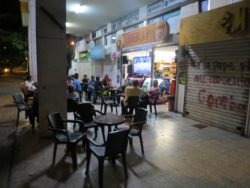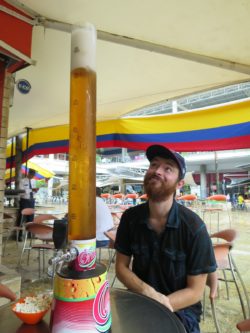Small Differences
When visiting a new country, you will of course notice many differences. Some of these differences are large and expected, such as the fact that everyone speaks a different language or that the typical cuisine isn’t quite what you’re used to. Other differences, however, aren’t so striking and sometimes even take a while to recognize. Each fairly minor, when they’re all put together, you start to build the picture of why a foreign place might actually feel foreign. There are plenty of examples of this in Colombia:
Liquor Stores with Tables – Like most of the civilized world, Colombia does not have a ban on open containers in public. An interesting side effect of that is that in addition to traditional bars, there is a large culture around drinking at local liquor stores which set up a few tables on the sidewalk just outside. The owner often acts as half bartender, half shop owner, and you’re asked if you want your beer opened or in a bag. There is usually a single TV with blasting speakers playing either fútbol or Colombian music videos. Thanks to the Colombian people’s famed friendliness, it’s not uncommon to be invited into somebody’s circle for conversation and numerous shots. As the night progresses, the voices and music get louder, the minds get fuzzier, and trying to make conversation in broken Spanish gets much, much tougher.
Music – While the style of music is obviously much different than you might be used to, the more subtle part of it is how ingrained music is in the people and culture. You’ll see old men pulling their carts down the street, belting a tune at the top of their lungs, school groups starting impromptu singalongs, and women singing while cooking. People also start to dance at the drop of a hat; it seems as though Colombians are born knowing how to salsa dance, and going out dancing is by far the most popular form of nightlife activity.
Police and Guards Everywhere – While much safer than it was a couple decades ago, Colombia is still in a somewhat transitional period, so in order to keep the peace, there are police and armed private security around every corner. Schools, banks, hospitals, even grocery stores have their own security forces. While slightly jarring at first, it eventually makes you feel more secure; nobody is really going to try to rob you when there’s a guy with a shotgun ten feet away whose entire job description is “don’t let people rob anyone”. There is also a different attitude between the police and the people than there is in the United States; the police in Colombia are public servants in the original sense of the word, and there doesn’t seem to be any sense of hostility in either direction. This may in part be due to the fact that all young men are required to serve for one year in a branch of the military, and in Colombia the police force is considered part of the military. Since serving in the police means you don’t have to leave your home, many men choose that option, and as a result, a large percentage of men in Colombia have actually been police officers at one time or another, perhaps creating less of an “us vs. them” mentality.
Fútbol Fever – There might as well be only one sport in Colombia. Everywhere you go, people are decked out in fútbol jerseys, even on days where there isn’t a match on. On game day, you’re hard-pressed to find a single person who isn’t excited and dressed for the occasion. Bars draw huge crowds and the beer flows like water, irrespective of the day of the week. When a goal is scored, the crowd erupts with infectious enthusiasm. There’s nothing quite like the entire country coming together around one game; in the States sports fans are divided between the three or four major sports, so there’s rarely a time where a whole region gets excited about the same game. Even then, since US sports are played between different cities or states, there’s never a time where the whole country is on the same side. In Colombia, every soccer match is like a mini-Olympics.
No Lawsuit Culture – This one is a bit harder to pin down exactly, but there just doesn’t seem to be as much of a propensity for jumping straight to a lawsuit when something goes wrong. People seem to be more willing to take responsibility for their actions, so you don’t have to sign a hundred waivers to do anything dangerous, and there aren’t warning signs posted around every business and public place. Some restaurants even have trampolines set up for the kids, which would be a lawsuit magnet in the US.
Plumbing – Not every difference is a great one. The plumbing in Colombia isn’t great, and as a result you can’t throw toilet paper down the pipes; there’s a small trash can provided instead. Pretty gross. Also, in much of the north, it is common not to have hot water, meaning plenty of cold showers to jolt you awake in the morning.
Motorbikes – Everyone and their Abuela rides a motorbike, so busy streets look more like a motorcycle really than a traffic jam. Traffic laws are bordering on nonexistent, and the bikes allow even more death-defying commute techniques, so naturally they’re very popular. It’s not uncommon for a bike to hop up on the sidewalk to get around a car or to find an impromptu parking spot. Keep your wits about you.
Long Pants – Despite the perpetually hot weather, not a single Colombian seems to wear shorts. Whether at work, church, lunch, the bar, or dancing, long pants may as well be the only style in existence. Wearing shorts is by far the easiest way to get recognized as a tourist, so be sure to pick up some slacks if you ever hope to blend in.











